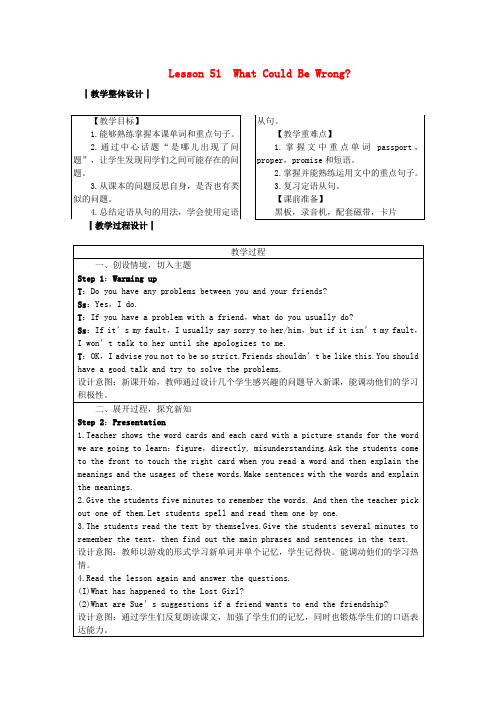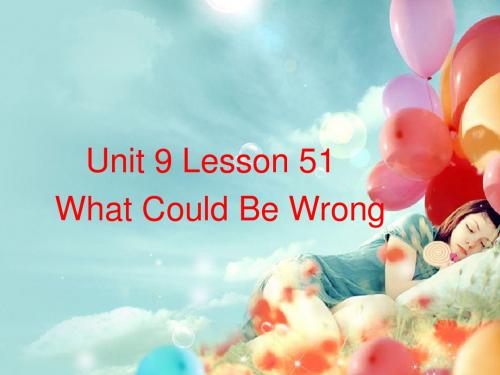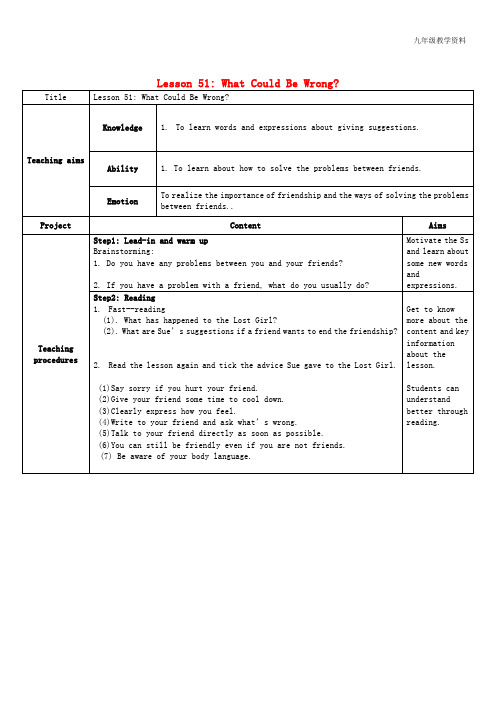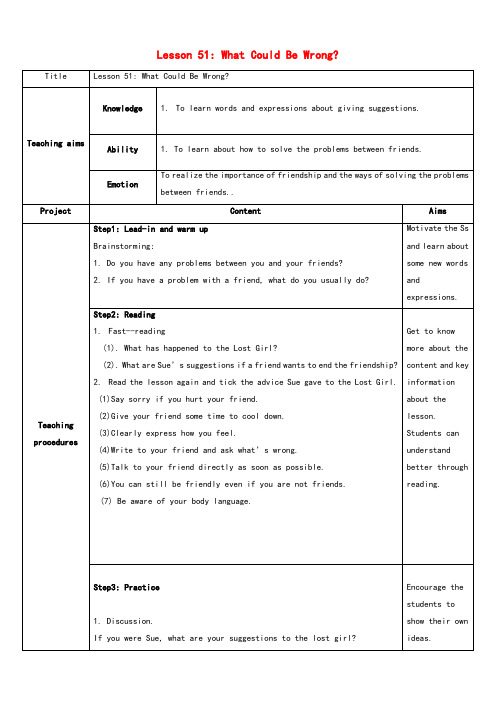冀教版英语九年级Unit 9 Lesson 51 What Could Be Wrong
- 格式:ppt
- 大小:738.00 KB
- 文档页数:2



Lesson 51: What Could Be Wrong? Title Lesson 51: What Could Be Wrong?Knowledge 1.To learn words and expressions about giving suggestions.Ability 1. To learn about how to solve the problems between friends. Teaching aimsEmotion To realize the importance of friendship and the ways of solving the problems between friends..Project Content AimsStep1: Lead-in and warm upBrainstorming:1. Do you have any problems between you and your friends?2. If you have a problem with a friend, what do you usually do?Motivate the Ss and learn about some new words and expressions.Teaching procedures Step2: Reading1.Fast--reading(1). What has happened to the Lost Girl?(2). What are Sue’s suggestions if a friend wants to end the friendship?2.Read the lesson again and tick the advice Sue gave to the Lost Girl.(1)Say sorry if you hurt your friend.(2)Give your friend some time to cool down.(3)Clearly express how you feel.(4)Write to your friend and ask what’s wrong.(5)Talk to your friend directly as soon as possible.(6)You can still be friendly even if you are not friends.(7) Be aware of your body language.Get to knowmore about thecontent and keyinformationabout thelesson.Students canunderstandbetter throughreading.Step3: Practice1. Discussion.If you were Sue, what are your suggestions to the lost girl?2. Team work.(1)Say sorry if you hurt your friend.(2)Give your friend some time to cool down.(3)Write to your friend and ask what’s wrong.(4)Talk to your friend directly as soon as possible.(5)You can still be friendly even if you are not friends.…3. Guess.After receiving Sue’s e-mail, what would the lost girl do?4. Listen to the reply from the Lost Girl and fill in the blanks.Dear Sue,Thanks for your advice. I have ________ all those things. I wrote her a letter and told her I wouldn’t want to lose her as a friend. I asked her what was wrong. She wrote back to me after she ________. There was a ________. She was hurt because I didn’t go back home with her on Wednesday as we had planned. She ________ me, but I didn’t answer her.I had forgotten that! After I ________ it was all my fault, I went to her and said sorry. We are now friends again. I’m very happy.Encourage the students to show their own ideas.Summarizethe expressions about how to give suggestions.Practice talking about how to solve the problems between friends.Listening will make the students know the lostgirl’s solutions to the problem.Step4:ProgressDOCTOR SUE SAYS!Work in groups. Write about a problem between two friends on a piece of paper.• Collect all the papers in the class.• Shuffle the papers.• Each group draws a piece of paper.Read the problem in your group and write some advice to that person.Emotion promotion.Make students learn to help others solve the problem between friends.Home-work 1)Write an e-mail to the person who has something wrong with his/her friend to give him/her some good suggestions.2)Write a story about how you make up with your friend.(Choose one between the two.)Board Design Lesson 51: What Could Be Wrong?Solutions to solve the problems between friends:(1)Say sorry if you hurt your friend.(2)Give your friend some time to cool down.(3)Write to your friend and ask what’s wrong.…。



课题:Lesson51:What Could Be Wrong? Array学习目标: 1、掌握单词:figure、experience、situation、directly、misunderstanding2. 学习运用短语:figure out 、leave somebody alone、cool down、ever since、write to sb 、neither of 、even if 、not …anymore 、think about3. 句子:(1).I still can’t figure out what the problem is .(2)Did you really hurt your friend?(3)Even if you’re not friends anymore, you should still be friendly.学习重点: 学习本课单词,理解课文,掌握重点词汇并完成练习。
学习难点: 掌握重点词汇并完成练习,复习定语从句。
学习方法: 小组合作探究学习过程:一.【温故知新,提出目标】1.Greet each other before the class.2.Show the learning aims.3.Go over the words.二.【预习检测,感知课文】1.Read the text ,then finish “Let’s Do it”Part1 and Part3三.【自主探究,解决问题】1. We used to study and play together all the time, but ever since last Friday. 我们过去曾经一起学习过、玩过,但从上个星期五就不一样了。
used to do sth“过去经常做…”,区别be used to doing sth“习惯于做…”。
否定句式有两种变化形式:used not to +动词原形didn’t use to +动词原形2. Say hi to her when you pass her in the hallway(走廊) at school. 当你在学校的走廊里从她面前走过时,要和她打声招呼。
Lesson 51: What Could Be Wrong? Title Lesson 51: What Could Be Wrong?Teaching aims Knowledge 1.To learn words and expressions about giving suggestions.Ability 1. To learn about how to solve the problems between friends.EmotionTo realize the importance of friendship and the ways of solving the problemsbetween friends..Project Content AimsTeaching procedures Step1: Lead-in and warm upBrainstorming:1. Do you have any problems between you and your friends?2. If you have a problem with a friend, what do you usually do?Motivate the Ssand learn aboutsome new wordsandexpressions. Step2: Reading1.Fast--reading(1). What has happened to the Lost Girl?(2). What are Sue’s suggestions if a friend wants to end the friendship?2.Read the lesson again and tick the advice Sue gave to the Lost Girl.(1)Say sorry if you hurt your friend.(2)Give your friend some time to cool down.(3)Clearly express how you feel.(4)Write to your friend and ask what’s wrong.(5)Talk to your friend directly as soon as possible.(6)You can still be friendly even if you are not friends.(7) Be aware of your body language.Get to knowmore about thecontent and keyinformationabout thelesson.Students canunderstandbetter throughreading.Step3: Practice1. Discussion.If you were Sue, what are your suggestions to the lost girl?Encourage thestudents toshow their ownideas.2. Team work.(1)Say sorry if you hurt your friend.(2)Give your friend some time to cool down.(3)W rite to your friend and ask what’s wrong.(4)Talk to your friend directly as soon as possible.(5)You can still be friendly even if you are not friends.…3. Guess.After receiving Sue’s e-mail, what would the lost girl do?4. Listen to the reply from the Lost Girl and fill in the blanks. Dear Sue,Thanks for your advice. I have ________ all those things. I wrote her a letter and told her I wouldn’t want to lose her as a friend. I asked her what was wrong. She wrote back to me after she ________. There was a ________. She was hurt because I didn’t go back home with her o n Wednesday as we had planned. She ________ me, but I didn’t answer her.I had forgotten that! After I ________ it was all my fault, I went to her and said sorry. We are now friends again. I’m very happy.Summarizethe expressions about how to give suggestions.Practice talking about how to solve the problems between friends.Listening will make the students know the lostgirl’s solutions to the problem.Step4:ProgressDOCTOR SUE SAYS!Work in groups. Write about a problem between two friends on a piece of paper.• Collect all the papers in the class.• Shuffle the papers.• Each group draws a piece of paper.Read the problem in your group and write some advice to that person. Emotion promotion.Make students learn to help others solve the problem between friends.Home- work 1)Write an e-mail to the person who has something wrong with his/her friend to give him/her some good suggestions.2)Write a story about how you make up with your friend.(Choose one between the two.)Board Design Lesson 51: What Could Be Wrong?Solutions to solve the problems between friends:(1)Say sorry if you hurt your friend.(2)Give your friend some time to cool down.(3)Write to your friend and ask what’s wrong.…。
冀教版英语九下Unit 9《Lesson 51 What Could Be Wrong》教学设计一. 教材分析冀教版英语九下Unit 9《Lesson 51 What Could Be Wrong》主要讨论了在某些情景下可能出现的问题,并通过对话形式引导学生学会用英语表达这些问题。
本课主要涉及到日常生活中的常见问题,如健康、交通、安全等。
通过本课的学习,学生能够提高英语听说能力,增强在日常生活中运用英语的意识。
二. 学情分析学生在学习本课之前,已经掌握了基本的英语语法和词汇,具备一定的听说读写能力。
但部分学生在实际运用英语进行交流时,仍存在一定的困难,特别是在描述问题和解决问题方面。
因此,在教学过程中,需要关注学生的个体差异,引导学生主动参与课堂活动,提高他们的英语实际应用能力。
三. 教学目标1.知识目标:学生能够掌握日常生活中可能出现的问题的表达方式,并学会用英语进行简单的交流。
2.能力目标:学生能够在实际情景中运用所学的英语知识,提高口语表达能力。
3.情感目标:培养学生关心他人,善于发现和解决问题的意识。
四. 教学重难点1.重点:学生能够用英语描述日常生活中可能出现的问题。
2.难点:学生能够在实际情景中运用所学的英语知识进行交流。
五. 教学方法1.情境教学法:通过设定日常生活情景,让学生在实际语境中学习英语。
2.交际教学法:引导学生参与课堂对话,提高他们的英语口语表达能力。
3.任务型教学法:通过完成各种任务,让学生在实践中学会运用英语。
六. 教学准备1.教学材料:冀教版英语九下教材、多媒体教学设备。
2.教学辅助工具:图片、卡片、录音机等。
七. 教学过程1.导入(5分钟)教师通过提问方式引导学生回顾已学过的日常生活相关知识,为新课的学习做好铺垫。
例如:“Can you remember the problems we talked about in our last class? What are they?”2.呈现(10分钟)教师利用图片、卡片等辅助工具,展示本课要学习的情景,引导学生关注并思考。